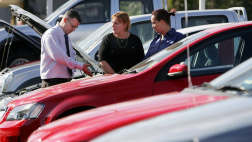No wonder that sales of the Toyota HiLux and Ford Ranger are so close - their load-carrying and performance specs are practically identical.
Prices are close on a spec-by-spec basis, as is fuel economy and power outputs. It makes the choice hard and leaves buyers relying on age-old brand loyalty, a better deal from a dealership or personal preference.
If you’re in the market for a ute, it can boil down just to what you want in the comfort and convenience stakes and how you recognise value.
But there are subtle differences beyond the shape of the grille and the name of the badge.
Ford is winding down its 3.2-litre five-cylinder turbo-diesel engine in favour of a 2.0-litre bi-turbo diesel four. The two have been selling side-by-side for a few years, but now that a V6 is on its way, it’s time for the five-pot to be set aside in favour of the newer engine series that meets yet another lot of upcoming emission rules.
Toyota continues with its 2.8-litre four-cylinder turbo-diesel, a relative of the previous 3.0-litre oiler. It’s a decent unit and Toyota says the spate of problems with its cantankerous catalytic converter are behind it.
.jpg)
The Ford is technically more advanced – two turbochargers and a 10-speed automatic win the chat around the barbecue with the mates anytime – but does the buyer profile in this category need the sophistication?
Both have a 3500kg tow rating but Ford’s Wildtrak wins the payload war at 954kg (as listed by the factory) compared with the HiLux SR5 at 797kg.
Hit the power button and Ford lists 157kW/500Nm while Toyota says its HiLux outputs 150kW/500Nm. Close enough, but peak power comes in earlier for the Toyota, while maximum torque is available sooner in the Ford.

Basic suspension kit is similar and in sharp contrast to the cutting-edge (well, for a ute) Ford drivetrain, there’s a simple live rear axle tipped by lumps of cast iron masquerading as drum brakes.
The Toyota, also a product of Thailand that taxes vehicles according to the level of rear brake and suspension sophistication, shares the drum brake spec.
Shrug off this acknowledgement of cost over efficiency and the rest of both vehicles stacks up very well, especially in the level of multimedia, comfort and particularly safety.
Both the Ford and Toyota have top-notch autonomous emergency braking as the halo kit, along with things like roll-over mitigation, trailer sway control, lane departure alert, pedestrian and (daytime) cyclist detection, parking sensors, reversing camera and six airbags (seven in the HiLux). That’s a passenger-car inventory.
Both also have Isofix and top-tether anchors for child seats and come with auto headlights.
Inside there’s a common theme with an 8.0-inch multimedia touchscreen and 4.2-inch multi-function instrument display (two in the Ford), six speakers, digital radio, sat-nav, voice activation and Apple CarPlay and Android Auto connectivity.

The HiLux also gets complimentary access for three years of Toyota Connected Services that offers stolen vehicle tracking, automatic collision notification and SOS emergency call.
Ford has a similar emergency assist system that runs through the mobile phone and its Sync3 multimedia unit, and is able to automatically call for assistance when it notes an inverted car or airbag deployment.
So, these two are similar enough to attract attention from buyers as wide apart as tradesmen and housewives. So much so that a brand-loyal buyer could even cross the floor to get the opposition.

But when it comes to ownership, are they still close?
Toyota will ask $60,680 (plus on-road costs) for the HiLux SR5 4x4 automatic dual-cab ute, a discount of $5410 to the Ford Ranger Wildtrak 2.0 Bi-turbo at $66,090 (plus costs).
After three years’ of ownership, Glass’s Guide expects the Ranger will hold its value better than the HiLux with a predicted 64 per cent of its purchase price available on resale, compared with 58 per cent for the HiLux.
The specs are close but get picky with the features and there’s a few extras in the Ford – bedliner with electric roller shutter, heated/folding mirrors and lift-assist tailgate for example – while the Toyota has some items not standard on the Ranger such as LED headlights.
If you have a tight garage the HiLux will be more accommodating because it’s smaller – almost 100mm shorter, 42mm narrower (with mirrors tucked in), although it is 17mm higher.
The Toyota is also lighter (by 136kg) at 2110kg than the Ranger and has a lower gross combination mass of 5850kg compared with the Ranger at 6000kg.
The GVM is 3050kg for the Toyota; 3200kg for the Ford and both share the 3500kg tow rating with payloads of 797kg and 954kg respectively.
Fuel costs
.jpg)
Toyota claims that the HiLux SR5 will average 7.9 litres per 100 kilometres while Ford says the 2.0-lite Ranger will drink at the rate of 7.4L/100km.
As we know too well, these are laboratory figures but we’ll use them anyway for this comparison.
Both take diesel and the cost at the bowser is currently all over the place – but mainly a high place.
The data here is based on driving the average of 12,000km a year and with diesel prices at $1.85 a litre.
At that annual distance, the HiLux will use 948 litres a year and the annual fuel bill will be $1754.
The Ranger will consume 888 litres of diesel, costing $1643 a year.
The difference is $111 which – when spread out over a year – doesn’t amount to much of a difference at all. Over three years, the HiLux will use $5262 of fuel and the Ranger will cost you $4929.
So, the cost of refuelling either ute is easily in the same ballpark. The two also each have an 80-litre fuel tank.
There is a price difference between the utes - $5410 - which plays a factor in cementing the choice between the two.
That purchase price difference is equivalent to running the Hilux for “free” fuel for a bit over three years.
It’s a saving that can’t be sneezed at, especially given the cost of fuel now and any predicted war-driven rise in the near future.
Ownership costs

Toyota’s capped-price service program is $260 a visit and lasts for three years or 60,000km. It sounds good but the service intervals are six months or 10,000km, so it’s $520 a year. Over three years, that’s $1560.
Over at Ford, it’s an annual service and the capped-price program costs $1430 for three years, comprising $360 in the first year, $610 in the second and $460 for the third. It’s a lifetime program and the costs are listed on Ford Australia’s website.
Toyota has no complimentary roadside assistance program but one is available for purchase. Ford throws in free roadside assist for seven years which is updated for 12 months after each dealership service.
The warranties are the same at five years and unlimited distance. But if the Toyota owner sticks to the service schedule, the warranty is extended to seven years.
Taking the service bill into the ownership costs, over the three years the running cost and fuel cost of the HiLux is $6822. The Ranger is $6359.
The difference is a comparatively small $463, meaning the running costs of both the HiLux and Ranger over there year are essentially the same.
But if you consider the difference in purchase price of $5410 and the fact that could buy you about three years of “free” fuel, the HiLux could be considered the winner.
More pragmatically, the purchase decision will be about what deal you get from your local dealer, the location of the service centre (especially Toyota because you’ll be there twice as often), and your preference in the brand and the vehicle’s features.
Verdict
It’s not cut and dried. The decision between you choosing a HiLux or a Ranger comes down to you – what you want, where you buy, what you prefer as a vehicle that you’re probably going to have to live with for at least three years.
Whatever the difference, cost won’t play a big part.


.jpg)


.jpg)

.jpg)
.jpg)



.jpg)




.jpg)


.jpg)
.jpg)
.jpg)



.jpg)




Comments